



Artists to my mind are the real architects of change,
and not the political legislators who implement change after the fact
(William S. Burroughs)
A large-scale model of a CCTV camera made from recycled cardboard peers through the window of the Seventeen Gallery out onto Belmont Street in Aberdeen, alive with passers by. This is the main piece of Under New Moons, We Stand Strong (2016), the project conceived and designed by Teresa Dillon to prompt reflections on solidarity, literacy and symbolism within digital civic governance.
If one gets close enough, it is evident that the eye of this camera is blind for there is no actual watching and recording apparatus inside. Still, the sensation of being watched remains. Bird spikes are mounted on top of the camera. The first thing one notices is the scale of the model: for the first time, what is an almost impalpable and invisible presence (surveillance technologies tend to be increasingly difficult to spot in the urban space) gets amplified, taking a physical presence that invites us to explore our personal relationship with surveillance and the multiple technologies that embody it.
The enlarged cardboard CCTV camera not only reminds passers-by of surveillance, its visual presence, eye to eye and the size of an other, functions to interpellate the viewer as an active gazer. Instead of us being the object of its gaze, the large-scale model allows us to look at the CCTV camera up-front. The exchange of gazes between the two subjects, the surveillance apparatus and ourselves, occurs on an equal level: we occupy a position that is not anymore subservient to the mechanical all-seeing-eye. In the act of looking at the CCTV cardboard model, we can also recognise our own complicit capacity to become overseers.
Teresa Dillon’s installation invites us to become aware of the change occurred in contemporary social and technological developments in the relationship between surveillance and society. This change is subtler than it might appear at first. The Panopticon, Bentham’s prison architecture, was discussed by Foucault in his Discipline and Punish: The Birth of the Prison (1975) as an exemplar, among others examined in the book, of the mechanisms of social control that become permanent and interiorised. The prisoners, in fact, have no need to be actually watched, they know that they might be being watched. The condition of being potentially under surveillance transforms the dynamics of the gaze, causing an interiorisation of the watchtower’s gaze, in such a way that the prisoner becomes her own overseer.
Surveillance studies have pointed out how the Foucauldian metaphor of the Panopticon fails to describe the multi-faceted contemporary figurations of surveillance. It is not anymore a matter of keeping the prisoners in a certain space, but much more of keeping them away. The movement from the Panopticon to the Banopticon, for example, exemplifies the attempt to use profiling techniques to determine who should be placed under surveillance for security purposes. The Banopticon can be described as the attempt to keep away certain social groups (asylum seekers, migrants, suspected terrorists) in the context of global security and border control. This ban, interestingly, is not exercised exclusively upon certain groups or in extraordinary circumstances, but also upon those individuals who do not have the resources (for example credit cards and smartphones) to promptly respond to the enticement of consumer spaces such as shopping malls.
We need to take responsibility for the way in which we exercise the power to look. This was the sense of the two talks arranged as part of Urban Knights, a program of events conceived to provoke and promote practical approaches to urban governance and city living by bringing together people who are actively producing alternatives to our given city infrastructures, norms and perceptions. Programmed during the opening of Under New Moons, We Stand Strong, the first talk saw Keith Spiller, a lecturer in criminology at Birmingham City University, discussing state surveillance and individual rights in the context of his practical experiences of accessing CCTV data in London. Heather Morgan, a Research Fellow at the Health Services Research Unit, University of Aberdeen, presented her on-going research on sousveillance (in the context of health self-monitoring wearable technologies). In the middle of our smart cities, caught up in the illusion of being in control of smart technologies we are actually constructing our own prison.
Dillon’s interventions successfully unfold what the two talks left implicit at theoretical level, that is the passage from Foucauldian surveillance to “surveillant assemblage”. Deleuze’s and Guattari’s concept of surveillant assemblage makes visible processes in which information is first abstracted from human bodies in data flows and then reassembled as “data doubles” (Deleuze and Guattari 1987). Thus, a new type of body is formed, whose flesh is pure information transcending corporeality. The body is an assemblage, comprised of component parts and processes that need to be observed. Moving away from a hierarchical top-down gaze, in a rhizomatic-fashion, surveillance expands in multiple fractured forms.
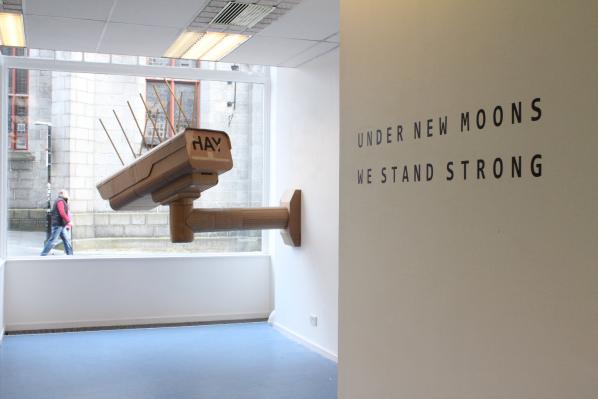
Going back to Dillon’s installation, on the gallery wall there is a digital print portraying a snowy owl in mid-air flight. This is a special edition print related to an episode on January 3rd, 2016 in Quebec, where a CCTV camera captured a stunning image of a snowy owl in mid-air flight. Four days later the images were tweeted by Quebec’s Transport Minister and went viral, turning the snowy owl into an “Internet star”. In Greek mythology the owl represents or accompanies Athena, the goddess of wisdom – and military strategy. Curiously, the next generation of surveillance technologies developed by the United States military bears the names of Greek mythological creatures. Argus Panoptes, which recalls the all-seeing giant monster with a hundred eyes, is a monitoring system that allows the constant surveillance of a city. Gorgon Stare, an array of nine cameras attached to an aerial drone, takes the name of the monstrous feminine creature whose appearance would turn anyone who laid eyes upon it to stone.
The owl is a highly metaphorical and yet ambiguous presence in the exhibition. On the one hand, the owl symbolises knowledge, wisdom and perspicacity. With its appearance, “flying only with the falling of the dusk” to paraphrase and transpose the famous passage from Hegel where the owl incarnates the appearance of philosophical critique and appraisal, the owl of Minerva (the Roman goddess identified with Athena) makes explicit the ideas and beliefs that drove an era but could not be fully articulated until it was over. Therefore, the owl is revealing something to us about our own epoch – it is our task to decipher the content of the message.
On the other hand, the owl is also the physical medium through which collaborative interspecies strategies of resistant actions to surveillance can be organised. Dillon’s techno-civic intervention, as the artist herself calls her work, is ideally connected to another artistic project, Pigeonblog, made by Beatriz da Costa, artist, academic and activist, member of the Critical Art Ensemble and graduate student of philosopher and science and technology scholar Donna Haraway. Pigeonblog was a grassroots initiative designed to collect and spread information about air quality to the public. Pigeons were equipped with small air pollution sensing devices capable of gathering data on pollution levels. The data could be then visualised and accessed by means of Internet (da Costa and Kavita 2008). Da Costa’s Pigeonblog was inspired by a photograph depicting a technology developed in Germany during wartime but then never implemented: a small camera, carried by a pigeon and set on a timer, was designed to take pictures at regular intervals of time as pigeons flew over specific regions of interest – possibly military targets. Pigeons were participating agents in this early surveillance technology system. Da Costa resuscitated that idea to create a surveillant assemblage formed by a living animal and technology but with civilian and activist goals.
By means of this mythological creature, the owl, Teresa Dillon asks us to learn to look at those technologies of surveillance, to re-adjust our gaze in order to be ready to face them upfront. The role played by mythology is evident not only in the installation but in the procession that accompanied the exhibition on Saturday May 7th. The public were invited to gather together and take part in a “forensic anthropological walk”, as the artist labelled it, throughout the city of Aberdeen, with participants holding hand-held models of two-dimensional CCTV cameras. Stopping in front of the CCTV cameras encountered in Castle Square during the walk, the artist revisited the world history of CCTVs, starting from the first documented use of surveillance cameras in Germany in 1942 for the documentation of Test Stand VII, the V-2 rocket testing facility, through the introduction of CCTVs in the urban landscape in the US in 1968, and more recent examples of surveillance technologies in the UK.
Dillon blends story-telling techniques with an emotional urban cartography created by means of walking together. Namely, the walk cannot be described in the guise of a city tour: the performative element transformed the walk into a procession, a collective rite, consumed on the Aberdeen beach where the paper cameras were set alight by participants. The history of surveillance technologies is in fact interwoven with mythological, symbolic and ritual elements, from the owl to the closing ceremony on the beach. Like in Cities of the Red Night, written by Beat Generation novelist William S. Burroughs, Dillon’s multiple interventions combines history with rituals and performance to evoke magical elements, doomsday scenarios and our phobias about the powers that control and enslave us.
The different interventions conceived and designed by the artist (the artwork itself, the performance, the walking tour through the city, the talks that accompanied the opening of the exhibition) can be read as artistic enactments of the cut-up and fold-in literary technique used to re-arrange and combine the pieces of a text to form new narratives. The technique can be traced back to the Dadaists of the 1920s. It was then popularised by Burroughs in the 1960s as a radical and creative method of socio-political subversion. It is evident that the cut-up and fold-in technique can be applied to contexts other than literature as Dillon demonstrates. It helps overcoming conventional associations (in this case, surveillance as a merely technological apparatus) to create new ones (the literacy infrastructure of surveillance), transforming the reader/player/visitor from a passive consumer of other people’s ideas into the architect of her own knowledge and action.
Under New Moons, We Stand Strong allows citizens to become not only more aware of the technological power infrastructure at work in our cities but also to learn how to read it, confront it, possibly resist it. The beach, at the outskirt of the urban space, a liminal site, nowadays often associated with the refugees crisis, becomes a space of freedom and catharsis. To set the cardboard cameras alight is, simultaneously, an act imbued with mythology – Prometheus’ gift of fire, the first techne, to humankind for their survival – and a collective gesture of transformation and renewal. Having freed ourselves from the idols, from all-seeing eyes, we can stay up-front, together, as a community, to face the darkness of our time.
Seventeen, Art Centre, 17 Belmont St, AB10 1JR, Aberdeen
Supported by Scotland’s Festival of Architecture, Peacock Arts Centre & Aberdeen City Council
Date: Thurs 5 – Sat 28 May 2016
Location: Seventeen, 17 Belmont St, AB10 1JR, Aberdeen
Opening: Thurs, 5 May, 6pm with special edition of Urban Knights
Procession: Sat 7 May, 8pm from Seventeen, 17 Belmont St, AB10 1JR, Aberdeen
Credits
Model & assistance: Jana Barthel
Commissioned by: Festival of Architecture, Scotland, 2016; Peacock
Visual Arts, Aberdeen & Seventeen Gallery, Aberdeen
In a mysterious pine forest, inhabited by half-human, half-animal creatures, the dismembered white body of a furry god is slowly reassembled. A creature with the head of a black bear pulls down the decapitated body from a tall rock. A red-robed character with a crimson wolf’s face, decorated with sharp white teeth, fetches the severed head. Another brings the eyeballs; another, the skull. Finally, in an illuminated multi-coloured tent glowing in the darkness of the woods, a character with the head of a triceratops and a cloak of many-coloured feathers performs a ritual involving magic crystals and a dead bird doused in blood. The film ends with a single glimpse of the white god’s foot, planted in a field of snow, sufficient to suggest that he, she or it has been brought back to life.
I first came across Magic Blood Machine as one of the staff picks on the Vimeo site in October 2014. It was on a list of spooky videos for Hallowe’en. The rest of them looked fairly conventional, but the still for Magic Blood Machine stood out: the red-robed character from the film standing amongst dark pine trees, looking a bit like a Roman Catholic Cardinal, a bit like Anubis – the jackal-headed god of Egyptian mythology – and a bit like Reynard the Fox. When I watched the video, I was struck by the same mixture of associations: it seemed to combine elements of the crucifiction and resurrection of Jesus, the dismemberment and restoration of Osiris, and the Green Man myth. Folk-stories, mythology, the occult, the macabre, and even a touch of science fiction were all in the mix. But its visual design, filmic and narrative qualities were just as striking. There are no words spoken, and the pace is slow, but nevertheless the film exerts a powerful compulsion, partly because of the expertise with which each sequence unfolds and leads us to the next, and partly because it’s so full of unanswered questions. The actions of the strange characters in the pine forest seem charged with hidden meaning, as do the characters themselves, sharply-differentiated from one another as they are by virtue of the brilliant costume-design. There is a strong sense of place in the outdoor filming, and a strong sense of the tactile as well: the way the characters stroke the dead god’s fur, fondle the magic crystals or pour blood over the breast of the dead bird, for example. And despite the use of expressionless masks, there are moments of powerful emotion. When the red creature, having retrieved the white god’s severed head, lays it next to the rest of the body and then sits beside the corpse, holding its hand, it eloquently conveys a sense of love and grief.
Magic Blood Machine was made by a Norwegian artist and film-maker called Ingrid Torvund, in close collaboration with her partner Jonas Mailand, and with music by Jan Erik Mikalsen. It took three years to make (2009-12), and a sequel called When I Go Out I Bleed Magic – which Ingrid describes as the second part of a trilogy – was released earlier in 2015. For me, When I Go Out I Bleed Magic is less compelling than its predecessor, but if anything the design of the film, in terms of costumes and settings, is even more impressive. Ingrid makes almost all the costumes and props herself, and they are works of art in their own right, some of which she has exhibited separately. She has also exhibited her drawings and published many of them in a book, again with the title When I Go Out I Bleed Magic.

Ingrid’s work strikes me as an example of the enabling power of the Web, which can sometimes allow genuinely original artists to reach international audiences they would have found it very difficult to access at any time before the 1990s. It also allows the likes of me to get in touch and start up a conversation out of the blue. Accordingly, I contacted Ingrid via email to ask about her work, and the results are reproduced below.
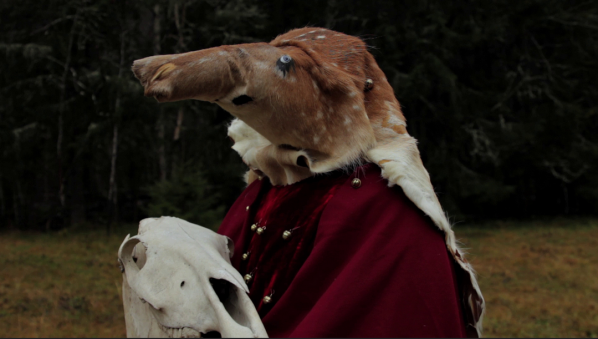
Edward Picot: Can I ask you about the making of the costumes and props for your films?
Ingrid Torvund: I make the costumes and props myself mostly, sometimes I get some help from my friends and family, if it´s large set pieces and so on. I like to take my time making these things, it`s a slow process but it´s one of these things that makes life worth living.
EP: Were you at art school, and if so did you study art, textiles, film or all three?
IT: I went to Oslo National Academy of the Arts,where I took a bachelor degree in fine art. While I was there I made my first short, “Magic Blood Machine“, and I worked on it for three years. I took courses in film, philosophy and many other subjects.
EP: Can you describe your creative process a little bit? Do you start off with an idea for a story, or with sketches in your sketchbook?
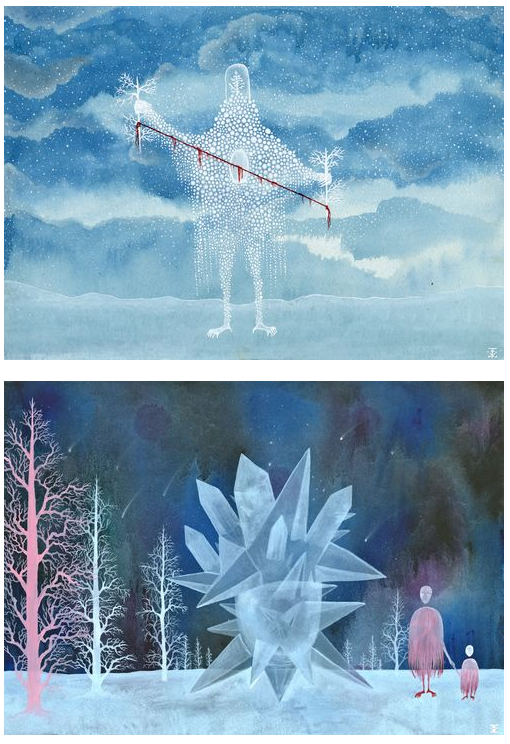
IT: it’s really random how I find inspiration, but sometimes I find a nice tactile material that I want to work with and I start by just trying out how and then I can make something that gives the audience the same feeling I got when I first saw it. And sometimes I get a picture in my head of a scene I want to make and then I try to figure out how to make it, then I draw it (but not very detailed and not very good 🙂
I wish I could say I plan out projects better, but I usually just make what I want to make. Over the years the planning of the filmprojects has become more detailed, but this is because I have to [plan things out] when I apply for funding and it’s a real creative killer.
For the last film “When I Go Out I Bleed Magic” we (me and Jonas) made a long storyboard with many scenes, but in the end we didn’t get to make them all due to lack of funding, lack of time and plain exhaustion.
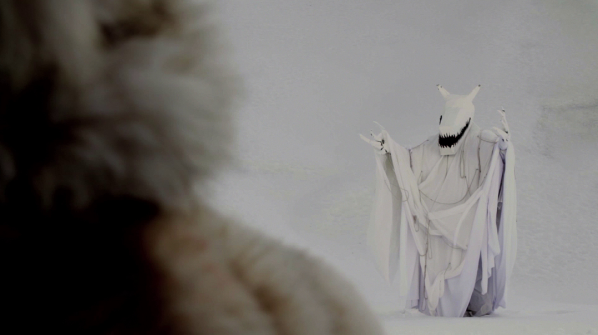
EP: You say you like to take your time making the costumes, props and so forth. Does this mean that your ideas about the film you’re going to make grow quite slowly and organically as you’re in the process of making things?
IT: Yes it does, it’s a long process and I usually try to finish one little part at a time: a costume, a set piece and so forth. But when the time comes to shoot the scene, I have to but all the pieces together, and then I have a time limit. In the two films I’ve made so far I’ve been borrowing my dad’s place, because there I have the space to actually build a little studio in the summer. But since this is his workplace normally, I have to clean it out before they come back from their holiday 🙂 So the summer is a really intense period in the year for me and I have to plan it out more, due to the fact that when I go to work there, I can’t get away, so I must buy all the materials I need before I go. I don’t have a car or a licence and it’s in the countryside. We do have a little boat that I can take to the grocery store 🙂
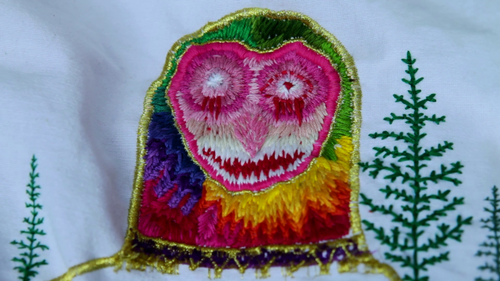
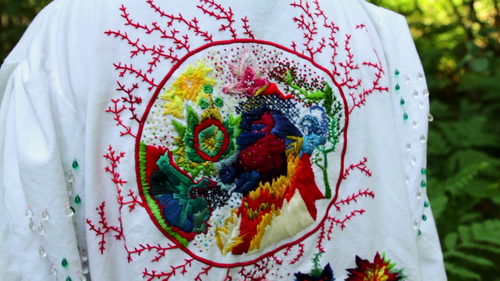

EP: You mention you’ve got a boat – and lo and behold, there’s the red character rowing a boat in Magic Blood Machine. I’m guessing from this that the boat in the film is your own boat, and the lake which appears in both films is the lake where you live.
IT: Yes, most of the places in the movies are from around where I grew up. I also think that it’s important to find inspiration from real and often personal things in life. it feels important to me to know that the project has some kind of root in something real. At my last exhibition my mother gave me some very old school books that I had made some drawings in, and it was almost disturbing how much some of them resembled some of my more current drawings!

EP: Let me ask you about Jonas. How do you work with him? How did you get to know each other and work together, and do you write together, or does he do the camerawork while you put on the costumes and do the acting?
IT: I met Jonas while we were going to an art school in Oslo seven years ago, at the time I was already making characters and installations and we started to date while I was building a forest installation inside a room. He has always had great interest for films and making them, and at that point I was thinking of trying to bring my characters to life by making them into costumes I could wear. After a year we started working on Magic Blood Machine. From that point he has done all the camerawork, while I do all the costumes, set pieces and “acting”. We usually edit the films together and sometimes we make an edit each and then compare them, and choose what we think works the best. I’ve been asked before how we collaborate on these projects and sometimes I find it a little difficult to answer, because we live and work together and we have no rules on who does what in these films. But I do know I spend most of my time thinking or working on these films and Jonas takes part in that if I ask him to. Without him I would not be able to make films like these and my life would suck.
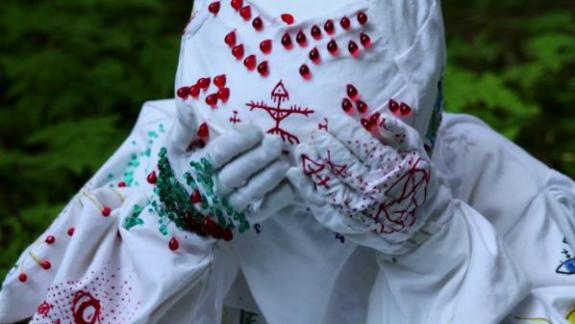
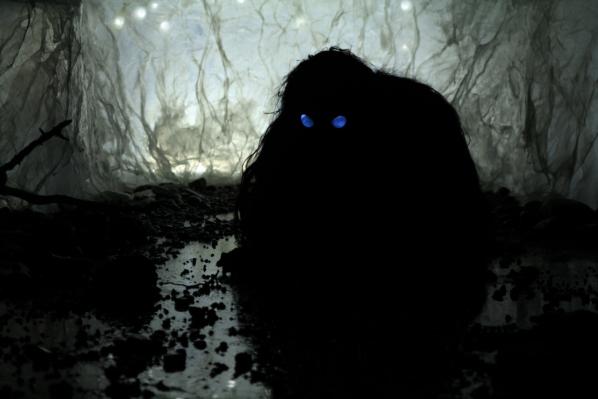
EP: Lastly, would you like to say a bit about the mixture of mythological references in your films?
IT: I have always been fascinated with the mixture of pagan and Christian culture. When I was young I found a book called “Norske Hexeformularer og magiske opskrifter”: it’s a collection of spells and magical recepies from 1600-1900. The spells are collected from small black books found throughout the country, often hidden away. Some would put them under the church steps in an attempt to get rid of them. My films are inspired by these rituals and the conflict between nature and religion. I grew up going to church a lot and I think the mix of church and folklore is something I use as inspiration when I make films.
I think I find the history of how people lived and their traditions even more fascinating then fairy tales, for example people used to think that their newborn babies sometimes got exchanged with a person from under the earth.The child then got some kind of physical change,like a weird growth or huge eyes or it suddenly looks very old. The only way to fix it was to lure the under earth person to tell you their real age. You did this by doing weird and absurd stuff, like making porridge in an eggshell or making blood sausage in an catskin. Then it would suddenly tell you how old it was and then it would die. Leaving a little lump of ash and bones…
More information about Ingrid Torvund can be found on her website, http://torvund.tumblr.com/. Magic Blood Machine is on Vimeo at https://vimeo.com/44936472, and When I Go Out I Bleed Magic is also on Vimeo, at https://vimeo.com/44936472.